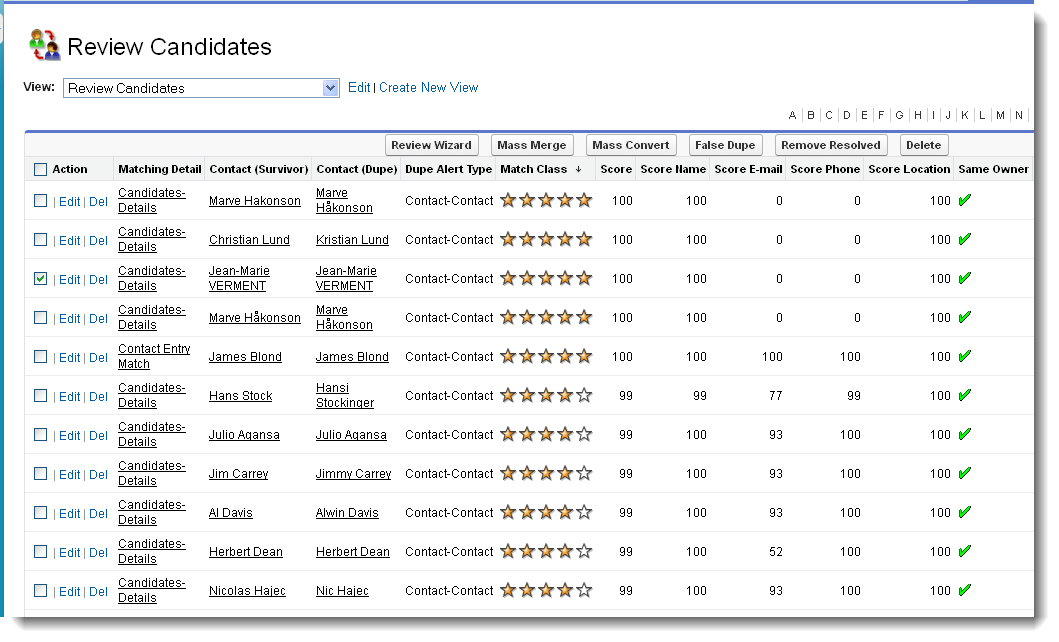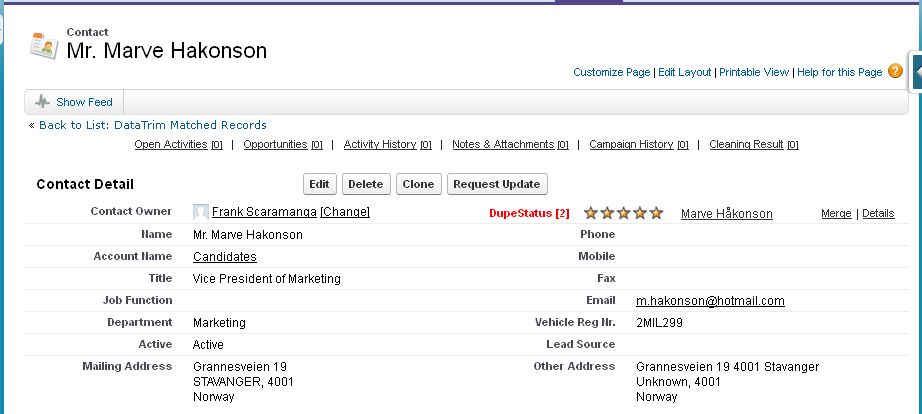Deduping candidates is a recruitment database isn’t always as easy as it sounds, especially if number of candidates reaches a certain volume.
“Deduping candidates requires a more delicate and sophisticated matching process than when deduping business contacts”

A traditional deduplication approach using a matching on first name, last name and email, or even including phone number and/or the address doesn’t always give the same results for a candidate database as it would do for a database with business accounts.
Here’s a few examples:
| Business Contacts | Candidate Contacts |
| Email is a good key, as businesses usually only issue one (1) email per employee, but some has none and some provide generic emails like info@ | May provide you with one of many private email addresses. |
| Mobile, office phone, switchboard number: you never really know what the phone field contain as primary phone.
Prospects may even provide you with a switchboard number to avoid too many direct calls. |
Normally private phones and mobile phones are kept apart, but a candidate assures that the number is a number where he/she can be reached, so this is reliable but a cross check between multiple phone numbers are still required. |
| The address provide is often the office address, which is useful when e.g. there are more companies on the same location, and the company names are spelled slightly different. Two contacts with similar names on the same location is more likely a duplicate than if they are in different geographical regions. | The address is most likely the private address, but as people change jobs they may also relocate and thus change their address. 2 duplicate candidates could therefor easily have completely different addresses. |
“Building match rules e.g. based on same name, same email, or same name same address will therefore not give you the full picture in a candidate database.”
But the matching of candidates is not only a special case due to the nature of the information and how it changes over time, but your database itself changes every day.
New candidates apply to jobs on your website, you import list of candidates and their resumes, and the recruiters enter daily new candidates and this all adds to the database on a daily basis.
Taking an intelligent approach to identifying duplicates
Matching candidates require a more delicate or sophisticated matching process where multiple elements; name, emails, phones, addresses etc. are all included in the comparison, and where each correlating information element between 2 potential duplicates adds to the likeliness of them being the same person. This likeliness or confidence indication is an important measurement in the action applied to these potential duplicates.
You might safely merge the exact matches and get rid of the most obvious duplicates in your database in a few clicks, but for the records with a lower confidence classification you may need to review and be more careful.

Alerting you about duplicates
The earlier in the process you can detect that the new candidate is an existing candidate the more time are you saving in qualifying and understanding the history of the candidate. So although the users can be guided in the candidate creation process to check if the candidate already exists, here are 5 functional areas to consider:
Top 5 areas to consider when deduping in a recruitment solution:
- Help users search properly before they create a new candidate. Don’t use the “I’ll-slap-you-over-the-fingers-if-you-do-this-again” approach, help them, guide them to avoid that they create a duplicate.
- Job applications from a web-site should be scanned before they are being processed. Only this way can it be updated with historic information from existing candidate records if it exists.
- Processing deduplication on data already existing in your database is required to clean up existing data. Scheduled or ad hoc deduplications are also a necessity to provide an underlying safety net for duplicates which may pass the 2 steps above.
- Engage your recruiters in the clean-up process. Let them review and merge records on the fly when they come across duplicates in your database; this creates ownership of data and helps you share the workload.
- Consider also that a candidate may be one of your customer contacts. When setting up your deduplications you must be able to segment your data and make sure you are matching the relevant data: imported data against existing data, candidates in a given country against themselves, or candidates against your customer contacts etc.
Note that deduplication is a 2 step process:
1) Matching the selected records and identification of potential duplicates
2) Reviewing the potential duplicates and taking appropriate actions.
As for the candidate records which also are customer contacts, you will not necessarily merge the records, but simply link them together so that you can consolidate the 360 view on this person whether you are the account manager working the customer contacts or the recruiter working the candidate.
You might even want to leave a part of the reviewing and decision making to the recruiter who is actually managing the candidates by making the information about the duplicates available to the recruiters or the account managers (as the example below shows).
DataTrim is a certified salesforce ISV partner who provides deduplication solutions for salesforce, regardless of how your data enter salesforce, we have a solution for you, read more at: www.datatrim.com

